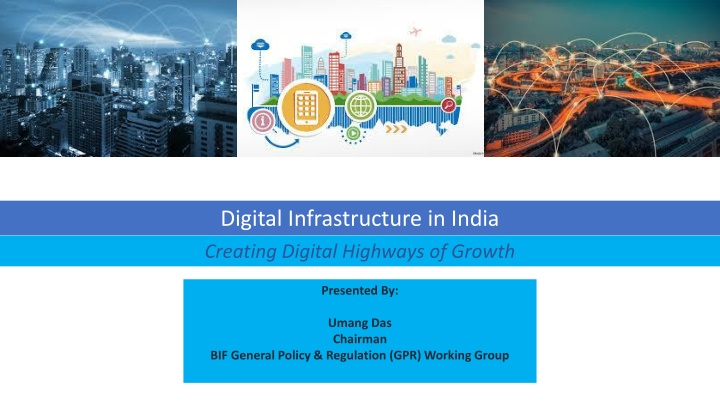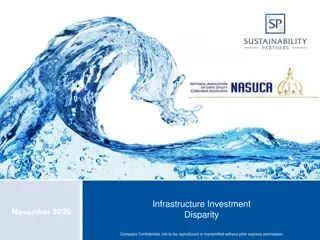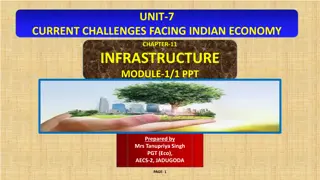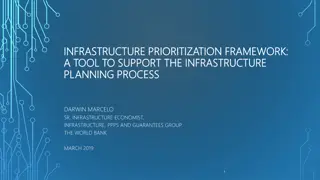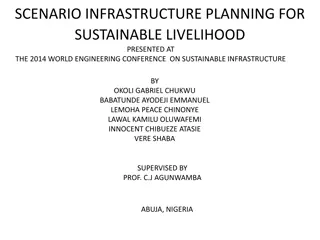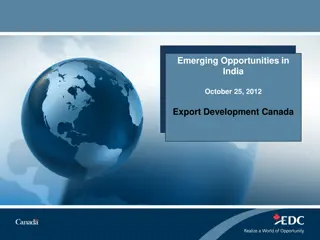Digital Infrastructure in India: Creating Pathways for Economic Growth
Digital infrastructure in India plays a crucial role in driving economic growth and development. The focus on creating a national digital grid and catalyzing investments in digital infrastructure is essential for the country's digital transformation. Improving digital infrastructure can unlock significant economic value, boost GDP, create jobs, and enhance overall well-being. The spillover effects of investing in digital infrastructure on the economy are immense, with broadband penetration contributing significantly to GDP growth. It is imperative to prioritize regulatory reforms, innovation, and consumer interests to harness the full potential of digital infrastructure for India's advancement.
Download Presentation

Please find below an Image/Link to download the presentation.
The content on the website is provided AS IS for your information and personal use only. It may not be sold, licensed, or shared on other websites without obtaining consent from the author.If you encounter any issues during the download, it is possible that the publisher has removed the file from their server.
You are allowed to download the files provided on this website for personal or commercial use, subject to the condition that they are used lawfully. All files are the property of their respective owners.
The content on the website is provided AS IS for your information and personal use only. It may not be sold, licensed, or shared on other websites without obtaining consent from the author.
E N D
Presentation Transcript
Digital Infrastructure in India Creating Digital Highways of Growth Presented By: Umang Das Chairman BIF General Policy & Regulation (GPR) Working Group
Contents Infrastructure is Becoming Digital Importance of Digital Infrastructure Spillovers Effects of Infrastructure on Digital Economy Challenges in Rolling Out Digital Infrastructure Way Forward: Creation of National Digital Grid Way Forward: Catalyzing Investments for Digital Infrastructure 2
Infrastructure is becoming Digital Components of Digital Infrastructure Towers/ antennas (IBS, DAS, Elements viz. RAN, Small Cells, Transmission) Fibreways (OFC) SatCom Digital Infrastructure Wi-Fi & Public Wi-Fi Hotspots Wireline infra 3 Without a holistic and balanced play of all these, we cannot achieve the end vision of Digital India.
Importance of Digital Infrastructure As per NDCP A recent study modelling Pune as a smartcity estimated that it can unlock an incremental value of 30% GDP valued at Rs 80,000 crore over six years. India's Digital Economy has the potential to reach 1 Trillion USD by 2025. From Rapid expansion of Digital Payments to evolve into widespread instruments of Access and Empowerment for more than a Billion Indians. This is for an area of 331 sq km and a population of 3.5 million. This study enabled the city to drive numerous digital service initiatives to capture the resulting growth potential of 15% CAGR (Purushottam Kaushik, L&T). It would be critical to focus on Digital Communications Infrastructure - this will form the Bedrock of Next Generation Technologies. And this is about just one city imagine this evaluation across the country. The Policy further aims to pursue Regulatory Reforms - Innovation and Consumer Interest. 4
Spillover Effects of Infrastructure on Digital Economy Improving the digital infrastructure will help achieve the goal of trebling GDP to USD 7.5 trillion over the next five years through increased usage of Internet 1 Impact of Digital Infrastructure on GDP Increased revenues from GST, license fee, SUC, spectrum auctions, corporate tax and property taxes Of all ICTs, broadband has the biggest economic impact 2.5 to 4.0 additional jobs for each new broadband job2 GDP per capita growth is 2.7 to 2.9 percent higher after the introduction of broadband3 Doubling broadband speeds adds 0.3 percent to GDP growth4 Impact of Broadband penetration on GDP Data based services or apps add for more value than just access to the internet. Apps contributed at minimum $20.4 billion to India s GDP in 2015-165. Potential to have this value increase to $271 billion by 20206 Each user of Applications in India receives on average $249 of consumer surplus annually. Applied to the total population, this number stands at $74 per capita7 Impact of Apps on GDP Sources: 1. icrier.org/pdf/open_Internet.pdf 2Broadband strategies handbook, Kelly & Rossotto, 2012, available at https://openknowledge.worldbank.org/handle/10986/6009 3Broadband Infrastructure and Economic Growth, Czernich et al, 2009, available at https://papers.ssrn.com/sol3/papers.cfm?abstract_id=1516232 4Socioeconomic effects of broadband speed, Ericsson, 2013, available at https://www.ericsson.com/res/thecompany/docs/corporate-responsibility/2013/ericsson-broadband-final-071013.pdf 5 6 Estimating the value of new generation internet based applications in India, Kathuria et al, 2017 available at http://icrier.org/pdf/Estimating_eValue_of_Internet%20Based%20Applications.pdf 7The economic and societal value of Rich Internet Applications in India, Arnold et al, 2017 Most of Spillover Effects of Digital Infrastructure Accrue to State and Local Governments 5
Key Challenges in Roll-out of Digital Infrastructure Obtaining Right of Way High RoW Charges Alignment of State Policies with RoW Rules 2016 Lack of Harmonized Policy Implementation Security High Taxes & Levies Operational Challenges Status of sector Funding constraints Funding Issues Challenges relate mainly to RoW clearances and funding 6
Way Forward: Creation of National Digital Grid Establishing a Collaborative Institutional Mechanism between Centre, State and Local Bodies for RoW, Standardisation of Costs and Timelines and Overcoming barriers to Approvals. Appointment by Centre of Senior Empowered 'Digital' Officer at State Headquarters with Clear Terms of Reference including Review Mechanism, and Dispute Resolution Empowerment High Level Quarterly Review at Centre with States and Selected Local Bodies. Implement Broadband Readiness Index and Review state-wise Performance in quarterly Review Meets as also Institute Awards for High Performing States. For Mobile Tower Infrastructure Accord Accelerated Permission for Telecom Towers at Government Premises. Incentivize Green Telecom Technology Implementation at Infra Sites. Allow IP1 Registration Certificate amendment to allow sharing of Active Infra with provisions to ensure that the Permission is only for Offering Infra Sharing only for Licensed Service Operators and any Violation will be liable to Penal Action. Sharing of Infra should be not only encouraged but be made mandatory to achieve National Objective of rapid Roll Out and Cost Optimization. Promote Next Generation Access Technologies by also promoting Wireless Backhaul Technologies and allow usage of E and V Band usage for Backhaul purposes only in line with International Best Practices. Leverage Existing Infrastructure By focusing on Fiberisation of Towers Setting up a Centrally Monitored Single Window to Monitor Tower and Fiber Assets and proper usage of the same in terms if sharing and availability as also QOS. Seminars/Workshops to be organized in Critical States by DoT Top Management with State Government and Local Bodies Top Level Bureaucrats to ensure alignment of State policies with DoT RoW directives. Education & Awareness programmes should be organized similar to EMF awareness campaigns organized by DoT. 7
Way Forward: Catalyzing Investments for Digital Infrastructure TRAI have estimated a requirement of USD 60 to 70 billion (INR 5 lacs Crores) for 5G in India TAIPA has assessed INR 1 lac crore for creating Digital Infrastructure over next 5 years for 5G ecosystem Formally accord Digital/Telecom infrastructure status of critical and essential infrastructure Prioritize access to low cost financing through International Financing Institutions viz. ADB Create a Policy Framework which is modelled on Public Private Partnership Play an active lead role in providing the Seed Capital Provide low cost 'INR' financing to the industry players Set-up The Digital/Telecom Fund It should be a Telecom Bank with Public-Private Board of Governance. Implement concept of input Line credit for avoiding double license fees and by treating Towers Infra as Plant and Machinery (currently tower is treated as a building) Promote Ease of Business in Terms of RoW Permissions and Approvals Unbundling of different layers of Telecom viz. infrastructure, Networks, Services and Application Layers as it will facilitate financing of individual layers. 8
Thank You facebook log.png www.facebook.com/broadbandindiaforum www.facebook.com/broadbandindiaforum Also find us on: facebook log.png www.broadbandindiaforum.com @connectbif @connectbif facebook log.png https://in.linkedin.com/company/broadband-india-forum https://in.linkedin.com/company/broadband-india-forum 10
